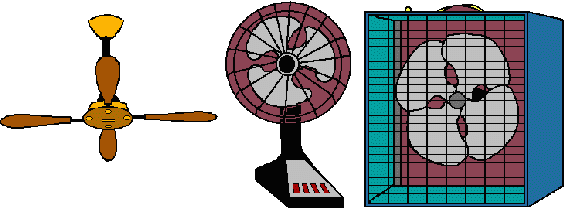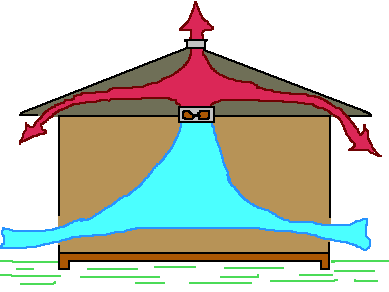FANS REDUCE COOLING COSTS
- GOAL:
-
- To become aware of inexpensive ways to help cut cooling costs by the proper use of fans.
- OBJECTIVE:
-
- The student will demonstrate a knowledge of different types of fans and an understanding of how the proper use of fans can reduce cooling cost.
- GLOSSARY:
- CFM - Cubic feet per minute. The amount of air that is supplied or exhausted by a fan.
- Cubic Feet - A volume of space obtained by multiplying square feet by the ceiling height or [width (w) x length (l) x height (h)].
- RPM - Revolutions per minute. The number of rotations in one minute is based on the speed it is turning.
- LESSON/INFORMATION:
- During the hot and humid summer months in Louisiana, air conditioning cost is a substantial part of the average home utility bill. Air conditioning can account for 30% to 40% of the total utility bill during the summer. Fans can go a long way in helping to reduce this cost. The two basic types of fans you can use are air circulating fans and exhaust fans.
- Air circulating fans allow human comfort at higher temperatures because they remove moisture from your skin by evaporative action. This allows one to raise the thermostat setting by 2° to 6°F. For each degree you increase the setting, you can expect approximately a 6% to 9% savings in cooling cost. Air circulating fans, such as ceiling, oscillating, or box fans (See Figure 1), can also
extend the natural ventilation seasons by keeping the air conditioning off during those more pleasant times during the Spring and Fall.

- Figure 1. Fans
- A ceiling fan consumes about the same energy as an ordinary light bulb. Of the three types, box fans are the most expensive to operate. These air circulating fans work only when someone is in the room to feel the air movement. It does not pay to leave these fans on when no one is around to enjoy them.
- Figure 2a.

- Ceiling fans can move air down or up depending on the tilt of the blades. Some fans can move in a clockwise or counter-clockwise direction depending on the need to move air up or down (See Figure 2a-b).

- Figure 2b.
- Exhaust fans are used to remove heat and/or moisture from an area. Heat should be exhausted only when cooler air can be drawn in. Moisture should be exhausted whenever excess moisture is a problem.
- One of the major problems of staying comfortable in Louisiana is the amount of excess moisture in the air. Therefore, we need to be very careful not to add moisture to the air. Exhaust fans will not lower the relative humidity of your home, but they will go a long way in preventing the rise of relative humidity. Exhaust fans should be provided in all areas that produce excessive moisture and heat, i.e., bath, utility, and kitchen. Exhaust fans should be vented to the exterior, but can be ventilated to a well ventilated attic space.
- Attic fans (power vents) do not ventilate your home, but remove excess heat from the attic (See Figure 3). Attic fans usually have thermostats that are set to exhaust hot air from the attic when the temperature in the attic exceeds the setting. Careful consideration must be given to the fan size (CFM's) and the amount of fresh air vent space available to allow outside air to be brought in. If enough vent space is not provided, the exhaust fan can pull air through recessed lights and other protrusions through the insulated ceiling and walls. It can also put an excessive strain on the fan motor (thus lowering its efficiency and consuming more energy).

- Figure 3.
- All of this is unnecessary if the attic is designed for natural ventilation. Attic fans are mainly used because of the poor design or inability to make corrections to allow for natural ventilation. The cost to run an attic fan equals about the same amount of money saved on the amount of air conditioning needed to combat the extra heat coming in from the attic. Using natural attic ventilation and making sure the ceiling is sealed and well insulated is strongly recommended. The installation of a ridge vent with adequate eave-vents usually provides the necessary ventilation. Also use a radiant barrier for all exterior surfaces with excessive sun exposure to reflect the radiant heat.
- Whole-house fans (formerly called attic fans) pull outside air into the home through any openings in the sealed insulated envelope and particularly through open windows or doors (See Figure 4). It is usually mounted in the ceiling and should be centrally located. It exhausts air back to the outside through the attic space. Again, attic vent area should be calculated to insure that the Whole-House Fan has adequate ventilation space for efficient fan operation. The whole-house fan can substantially increase air movement to help you stay within the comfort zone at higher temperatures. They are also very beneficial in removing heat from the home that has built up in the building and the contents. Venting air through the attic removes excessive accumulated heat and subsequently reduces the transfer of the heat to the interior. Whole-house fans are mainly used when outside temperatures are lower than inside temperatures. Whole-house fans should be sized to remove one to six complete volumes of air from the dwelling per minute. For a quieter fan operation, the motor should run at 500 RPM or less. Depending on the situation, dust, moisture, and outside noises could also be pulled into the house. However, if used properly, the whole-house fan can be very beneficial in Louisiana. Whole-house fans can also be used to warm the dwelling when exterior temperatures are higher than interior temperatures during the mid-mornings in the Spring and Fall when there are cold nights and warm, sunny days.

- Figure 4.
- ACTIVITY 1:
- Size the CFM of a whole-house fan to remove four complete volumes of air per minute from a dwelling that is 30' wide and 45' long with an 8' ceiling height.
- ACTIVITY 2:
-
- Fill in the Blanks.
- 1. CFM is the _______________________________ of air moved in one minute.
- 2. The volume of a space is measured in ______________________________________ .
- 3. RPM stands for ____________________ per _______________________ .
- 4. _____________________________ cost is the highest utility load on a home in Louisiana.
- 5. Air circulating fans allow for human comfort at ______________________ temperatures.
- 6. Ceiling fans consume about the same amount of energy as a __________ watt light bulb.
- 7. It does or does not (circle one) pay to leave air circulating fans on when no one is around to enjoy them.
- 8. Exhaust fans are used to remove ___________________ and ________________________ .
- 9. Exhaust fans should be vented to the _________________________ .
- 10. It is best to remove heat from the attic by ____________________________ .
- ACTIVITY 3:
- Divide the class in two groups and ask them to list ways in which fans can reduce use of air conditioning.
- INFORMATION CHECK:
- Please indicate whether the following statements are TRUE or FALSE.
- ___1. Air conditioning can account for 30% to 40% of the utility bill in the summer.
- ___2. Fans can help reduce cooling cost.
- ___3. Air circulating fans make the human body feel cooler by radiation.
- ___4. Air circulating fans allow human comfort at higher temperatures.
- ___5. For each degree of increase on the thermostat, you can expect 2% savings in cooling.
- ___6. Ceiling fans use about the same amount of energy as a 100 watt light bulb.
- ___7. Exhaust fans are used to add moisture to an area.
- ___8. Louisiana doesn't have enough humidity.
- ___9. Attic fans are used to ventilate the house.
- ___10. Whole-house fans are used to ventilate the house.
- TEACHER'S NOTES:
- Answers to Activity #1:
- 30' x 45' x 8'/4 = 2,700 CFM (Cubic Feet per Minute).
- Answers to Activity #2:
- 1. CFM is the Volume of air moved in one minute.
- 2. The volume of a space is measured in Cubic Feet.
- 3. RPM stands for Revolutions per Minute.
- 4. Air Conditioner cost is the highest utility load on a home in Louisiana.
- 5. Air circulating fans allow for human comfort at higher temperatures.
- 6. Ceiling fans consume about the same amount of energy as a 100 watt light bulb.
- 7. It does not pay to leave air circulating fans on when no one is around to enjoy them.
- 8. Exhaust fans are used to remove heat and moisture.
- 9. Exhaust fans should be vented to the outside (or exterior).
- 10. It is best to remove heat from the attic by natural ventilation.
- Answers to Information Check:
- 1. True
- 2. True
- 3. False
- 4. True
- 5. False
- 6. True
- 7. False
- 8. False
- 9. False
- 10. True
- RECOMMENDED READING:
- Building Control Systems. V Bradshaw. New York: John Wiley & Sons, 1985.
- Natural Louisiana Architecture. Cazayoux, Hebert and Winn. Baton Rouge, LA: Louisiana Department of Natural Resources, 1991.
- REFERENCES:
- "The Comfort Zone" .....E.J. Cazayoux, USL Monthly Press Release.
Comments or questions to: TechAsmt@LA.GOV
Return to Drafting Menu









